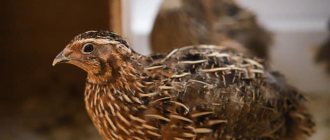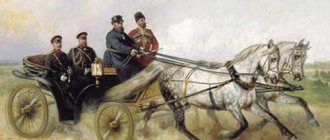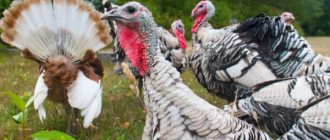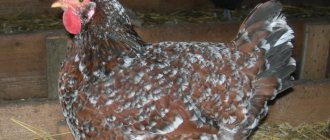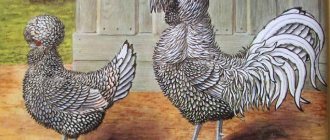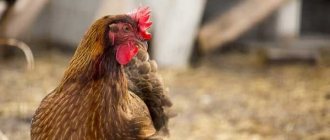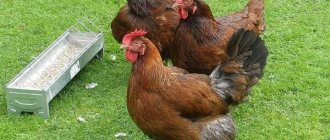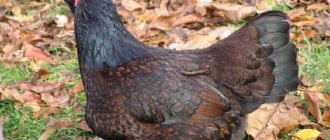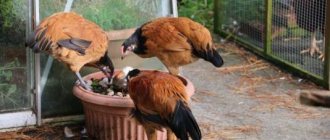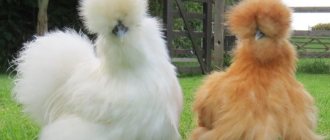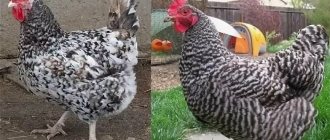Poultry farming » Turkeys
0
1385
Article rating
Kira Stoletova
Most people associate turkey with Thanksgiving, because in fact it is the most striking symbol of this holiday. This bird is a real decoration on the farm and a source of the most tender meat. There are a lot of breeds, but one of the first positions on the list is still occupied by bronze turkeys. Because they differ from all others with their unique characteristics.
Description and characteristics of the breed
Representatives of this breed grow very large. You probably won't find a single bronze broad-breasted turkey that weighs less than nine kilograms.
Attention! Juveniles weigh on average about eleven kilograms, and adult birds weigh at least eighteen kilograms.
Experienced farmers claim that with abundant feeding and following the rules of care and reproduction, it is possible to raise turkeys weighing up to thirty kilograms. Bronze turkeys also have another name - “American”. It reminds us that the breed was developed in America.
Important! This breed can be crossed with other, less meaty breeds to improve characteristics and create new varieties of turkeys.
The body of these birds is oval, the chest is wide, convex and very strong. The graceful gait and powerful legs give the breed even more nobleness. The bronze broad-breasted turkey has beautiful plumage, black feathers shimmer in the sun with bronze, purple and bluish tints. Bronze is the predominant color, as indicated by the name of the breed. Males are distinguished by a fan-shaped, elegant tail.
Diseases and their treatment
Diseases to which bronze turkeys are susceptible are divided into contagious and non-contagious. The group of infectious diseases includes: histomoniasis, paratyphoid fever, pullorosis and helminthiasis.
Histomoniasis (or "black head")
Sick birds refuse food, become lethargic, disheveled, and quickly lose weight. Their feces acquire an unpleasant odor and are first yellow-green in color and then brown. In some individuals, the head becomes noticeably darker. An autopsy reveals liver damage.
Treatment:
Sick birds are isolated from the general flock and given a solution of metronidazole (2 tablets per 1000 ml of water). An improvement in the condition is observed the next day.
For prevention, healthy livestock are fed once a day with feed to which metronidazole has been added (at the rate of 6 tablets (250 mg) per kg of feed). Metronidazole can be replaced with Trichopolum in the same dosage.
Pullorosis (or "white diarrhea")
In turkey poults, the disease is acute and often fatal. In adult turkeys, pullorosis can be chronic.
Infection of chicks occurs through eggs or from adults.
Chronic pullorosis is asymptomatic, so it can only be detected through laboratory testing.
Chicks infected with pullorosis become ruffled, lose their appetite and squeak pitifully. With their paws spread wide and breathing heavily, they stand with their eyes half-closed. They may have seizures before they die. Throwing their heads on their backs, the turkey poults roll over.
Debilitating diarrhea is white in color and has a disgusting smell. Fecal matter stains the fluff and often causes cloaca blockage, which can be fatal.
Treatment consists of using antibiotics that dissolve well in water. The preparations “Baytril 10%” or “Tilan” are diluted with water (0.5 ml per 1000 ml) and the chicks are given water for five days. Cured birds continue to be carriers of this infection, so the eggs they lay are unsuitable for incubation.
Paratyphoid
Paratyphoid fever is an infectious disease that can destroy at least 80% of the livestock. It is especially dangerous for chicks under three weeks of age.
Paratyphoid fever is characterized by an unsteady gait and a lethargic state in sick birds that have lost their appetite and are very thirsty.
Discharge from their eyes may stick their eyelids together. Diarrhea, contaminating the fluff located around the cloaca, often causes its blockage.
Treatment:
Turkeys showing signs of paratyphoid fever should be immediately isolated from healthy birds. They are given a solution of the veterinary drug “Mepatar” (10 g per 5 liters of water). Discharge from the eyelids and contaminants from the cloaca are washed off regularly.
As a preventive measure for paratyphoid fever, the entire turkey population is regularly given furazolidone.
Helminthiasis
In turkeys susceptible to all kinds of helminthiases, parasites can penetrate the muscles, the respiratory system, and any part of the gastrointestinal tract. Adults affected by helminthiasis, having lost a significant part of their body weight, become apathetic and lethargic.
Turkey poults stop growing and gaining weight: their legs become so thin that they seem dried out.
Treatment of helminthiasis is carried out with broad-spectrum drugs. When worms of a certain type are detected, specialized drugs are used. The most commonly used tablets are Alben.
They are added to turkey feed at the rate of 1 tablet for every 40 kg of live weight.
Smallpox
An extremely contagious pathology, transmitted through contaminated equipment, bites of blood-sucking insects and through contact with sick birds.
Sick turkeys lose their appetite, become lethargic, and walk with drooping wings and ruffled plumage. Individuals affected by the disease are huddled in a dark corner. On open areas of the skin and mucous membranes, spots appear, in place of which ulcers or scabs appear.
There are still no effective methods for treating smallpox, so sick birds must be killed and burned. As a preventive measure, six-week-old turkey poults are given a smallpox vaccine. Non-contagious diseases of turkeys are most often the result of improper feeding and maintenance.
Hard goiter
The cause of a hard goiter is improper feeding. Most often, this is due to an excess of grain in the diet and a complete lack of coarse sand and shell rock, which helps grind rough food.
Pathology can occur during time-limited feeding, when hungry turkeys are in a hurry to fill their crop.
A droopy (water-filled) crop may appear in turkeys that are thirsty in extreme heat.
Turkeys affected by the disease refuse food and, ruffled, sit on the sidelines, showing no interest in their surroundings. When palpated, they reveal a highly swollen crop, overflowing with water or tightly stuffed with food.
There are no treatments for hard goiter, the mortality rate is 100%, so sick birds are immediately slaughtered for meat. Turkeys with drooping crops have a chance of salvation. On the first day, it is necessary to create a calm environment for them and put them on a starvation diet.
Over the following days, the amount of food is gradually increased to normal and constant access to water is provided.
Advantages of the breed
There are many advantages of this breed over other types of turkeys. We will try to list the main advantages:
- high egg production. These turkeys differ in both the quality and quantity of eggs. In one season, a turkey can lay down about 120 of them. Of these, 96 eggs can be fertilized, and from 67 small turkey poults will hatch;
- maternal instincts. Turkeys of this breed are caring and attentive mothers. They hatch their offspring with great patience. Moreover, they can also be planted on the eggs of other birds, such as chickens or ducks;
- precocity. At the 20th week of life, bronze turkeys can weigh up to eight kilograms, and turkey hens can weigh at least fourteen kilograms;
- profitability. There is no need to feed these turkeys for a long time. They are usually slaughtered twenty weeks after birth. The reason is that after this age, birds need much more feed to maintain their weight, and even more so in order to build even more muscle mass.
Important! Up to twenty weeks, turkeys consume one and a half kilograms of feed per kilogram of weight per day.
Differences between females and males
In order to form an adult family intended for further reproduction, the poultry farmer must learn to distinguish females from males, focusing not on the color of the plumage (in turkeys and turkeys it is almost identical), but on a number of characteristics presented:
- Body weight. In a turkey it is a full third less. Differences in weight begin to appear in 4-8 week old chicks, only increasing steadily over time.
- Fleshy red projections (called “corals”) on the unfeathered part of the head. Above the beak of turkeys there is another – longer – nasal growth (or “worm”). Noticeable already in one-month-old turkey poults, the growths begin to actively grow when the chicks reach 2-3 months of age. They reach significant sizes only in males. During sexual arousal or aggression, the growths of males become engorged with blood, acquiring a white or bluish tint. This is never observed in females.
- The presence of a brush, consisting of a bunch of thread-like long feathers, located in the very center of the chest exclusively in males.
- The presence of spurs that grow on the tarsus of males after reaching puberty.
Disadvantages of bronze turkeys
The bronze broad-breasted turkey is suitable exclusively for breeding in industrial conditions. They will not be able to fully develop in pastures or even in the yard. Only cages and barns are suitable for raising bronze broad-breasted turkeys. These birds can be fed only with balanced feed containing all the necessary vitamins and minerals. You should also add various fertilizers. You can prepare a mixture of grain and chopped grass for turkeys. And veterinarians advise adding special vitamin complexes from time to time. As you can see, breeding such large individuals is a little expensive, but the amount of meat obtained is, of course, worth it.
Types of Bronze Turkeys
The largest birds
In the mid-60s of the last century, a new breed was developed, which was called the Caucasian bronze turkey. Inexperienced farmers often confuse it with regular one, but it differs in a number of characteristics. To improve productivity and weight, the North Caucasian turkey is crossed with other breeds. The greatest distribution of this species is in the southern part of Russia, hence the name north or simply Caucasian, as well as in Ukraine, Belarus, and Northern Asia. The very first difference from bronze broad-breasted turkeys is in weight; the body weight of this breed is on average half that, males 10-11 kg, females 5-6 kg. The egg production rate is also not particularly high, 65-70 eggs per productivity period.
At the very beginning, turkeys of the bronze breed were bred for industrial conditions, so the birds do not adapt well enough to other feeding options (walking). To achieve the desired level of productivity, the producer must correctly recreate the conditions for keeping the birds.
- The Bronze Broadbreast needs a well-ventilated and spacious building. The ideal solution would be to keep turkeys in an aviary. To do this, one male and several females are placed in one enclosure.
- Despite the fact that the weight of birds of the broad-chested breed is very large, and sometimes even frightening, they consume so much food in one day. The main thing is that it is rich in vitamin complexes and antioxidants with minerals, and is also as balanced as possible. Some farmers also add nutritional supplements to improve the health of birds. Suitable feed: grain, cereals (mash), grass, etc.
- Up to 20 weeks, bronze broad-breasted turkeys consume an average of 1.5 kg of feed per kg of body weight per day.
Canadian Bronze Broad-breasteds are the largest of these domestic birds. This breed is meat broilers, in which the weight of a turkey can reach 15-30 kg, and in this case, this indicator does not indicate any anomalies. Keeping these birds is economically beneficial; they are not picky about their diet, and the optimal weight is achieved in 2-4 months. Therefore, at the age of 1.5 months, turkey poults of the Canadian breed have the weight of an adult duck. But the main thing that farmers should pay attention to is that chicks quickly catch intestinal infections and other diseases.
For their breeding, a well-lit, clean and warm poultry house is necessary. Canadian bronze broad-breasted turkeys cannot thrive in close quarters, so it is necessary that the room be spacious. The minimum acceptable air temperature in the poultry house is 5 -7 degrees, the maximum is 29-30 degrees Celsius.
The Moscow Bronze Broad-breasted Turkey is a unique species of bird. Indeed, unlike others, this breed thrives in open areas, so they can be bred and kept in farmsteads, and not just in poultry houses. The average weight of Moscow bronze broad-breasted turkeys reaches 18-20 kilograms. Turkeys are half the size.
France in modern times is one of the leaders in breeding this breed. Many French farms, along with America and Russia, raised quite good individuals, which, due to the place of production, became known as the “French bronze broad-breasted turkey.”
Productivity
Bronze broad-breasted turkey poults have a very high survival rate. They are disease resistant and strong. All thanks to the original breed, the crossing of which produced bronze turkeys. She was distinguished by high levels of endurance and had excellent health.
The main goal of breeding this breed is to obtain high-quality and tasty meat. It tastes a little like game. The big advantage of turkeys being slaughtered young is that the meat remains tender and soft. Moreover, up to 80% of the total mass of the carcass is meat. It is an excellent dietary product because it contains only 8% fat.
Turkey eggs are also used in cooking. They are round in shape and large. They have an unusual brown color, with specks of different sizes located throughout the egg. They can be seen in the photo.
Turkeys of the bronze broad-breasted breed begin to lay eggs at the age of nine months. The minimum number of eggs laid per season is about 60, and the maximum is approximately 150 eggs per year. Not only can they incubate the eggs of other bird species, but they also take care of them as if they were their own. Turkeys can easily be trusted with small geese, ducklings and chickens.
Advice! In order for the bronze broad-breasted turkey to hatch other birds, it is necessary to lay eggs a week after she begins to hatch turkeys.
Advantages and disadvantages
Advantages of the bronze broad-breasted turkey:
- Increased fertility, excellent productivity;
- Relatively low food consumption;
- Excellent maternal qualities, the ability to care for a large brood and hatch other people's eggs. Babies do not need the care of the owner;
- Breeding is no more expensive than maintaining other, less profitable breeds;
- Excellent adaptability to the environment;
- Disease resistance;
- Precocity, rapid achievement of slaughter age;
- High profitability;
- Bronze turkey eggs are very large and strong.
Flaws:
- Pasture intolerance;
- The appearance of the carcass after slaughter is not very attractive. It is painted brown;
- Birds willingly leave the territory at the first opportunity, but cannot return home, which is why the owner suffers losses.
Breed care
The bronze broad-breasted turkey can only fully grow in a spacious room. It is very important to maintain a stable temperature in it, as well as air humidity. These birds do not tolerate drafts well. For normal living, one individual will need 1 m2 of space. Birds should not sit on a cold floor, so it should be lined with hay or straw. The room with turkeys should be well lit and also have ventilation.
Long feeders and drinkers are built for the birds so that all the birds can eat from the same container. It is necessary to arrange roosts for turkeys. They should be no higher than 50 centimeters from the floor. At the bottom you need to place pull-out trays for collecting litter. The room temperature should not fall below -8 °C, as it is destructive for this breed of bird. In order for the birds to receive all the necessary nutrients, it is necessary to add nettles, sauerkraut, and green hay to the turkey feed.
In spring, you need to do a general cleaning of the room. It should be disinfected using caustic soda and hot water. The litter definitely needs to be replaced.
Advice! To repel blood-sucking insects, you can hang bouquets of herbs with a pronounced smell on the walls of the turkey poultry.
Productive indicators
The Bronze Broad-breasted turkey is famous for its incredibly fast maturation. At 23-24 weeks, these are already fully formed birds that are suitable for meat production. Please note that males reach the required weight about a week later than females.
At the moment, birds of this breed are very often used for breeding work. And this is not difficult to explain; hybrid breeds are characterized by high productivity and hatchability of chicks (85-90%).
Bronze broad-breasted turkeys are not only famous for their excellent-tasting meat, but also for their high egg production. During one productive period, one female is able to lay up to 120 large eggs.
The turkey is an excellent hen; she hatches both her own and other people’s eggs with great pleasure. Since hatched turkeys are wet, wait until they dry and place them in a place with a temperature of at least 30-31 degrees. After all the turkey chicks hatch, you can safely let them near their mother, since she has a very developed maternal instinct and you don’t have to worry about the brood at all. The percentage of hatchability of turkey poults is very high, as is the survival rate, so that even one turkey can give a good increase in the number of livestock.
Bronze turkeys are an ideal breed for raising and breeding on home farms, even despite some inconveniences in terms of maintenance. They will very quickly recoup all the costs that were spent on them. So it is absolutely not in vain that the bird deserves its leading place among other turkey breeds. And, importantly, work to improve the performance of this breed continues today.
What is the productivity of a bronze broad-breasted turkey?
An important criterion when purchasing a breed for breeding is productivity. So, what qualities can a bronze broad-breasted turkey boast of?
- An adult female weighs up to 9 kg, a male – 16 kg. Maximum fixed weight – 35 kg!
- Individuals are slaughtered by the 6th month, when they reach 7.5-13 kg. You can do this by the 13th week, but at this age males weigh no more than 4.4 kg.
- The actual meat yield is 66%.
- Meat is dietary. The amount of protein is equal to beef, there is very little fat in it. Has a lower cholesterol index.
- Egg production – 120 eggs per year, 80-90 grams each. The shell has a grayish tint with brown, dark, uniform specks over the entire surface.
Maximum fixed weight – 35 kg!
In addition, the Broadbreasted Bronze turkey is often bred for sale, as the young are expensive. You can also sell fertilized poultry eggs for further incubation. Quite often, adult turkeys are “surrendered” for mating or for breeding work for a substantial fee. True, in this case, the animal must have all the necessary vaccinations and meet the criteria for purebredness.
Of course, like any other poultry, this one has some disadvantages. Knowing them, you can prevent a possible problem in advance or at least be prepared for it.
- The skin of turkeys after slaughter and plucking is dark in color. This does not affect the taste or quality, but may interfere with implementation.
- Turkey is sensitive to dampness and severe frost.
- Despite their large mass, they fly actively, so a high fence on the paddock is mandatory.
Feeding
Maximum productivity indicators in industrial breeding can only be achieved by intensive feeding of poultry with compound feeds with a balanced vitamin and mineral composition.
Breeding Bronze turkeys at home is possible using grain mixtures, freshly cut grass, and vegetables 3 times a day. Turkey poults up to 2 months are fed up to 7-8 times a day with the addition of cottage cheese, wheat cereal and finely chopped eggs to the diet.
The best food for turkey poults
Top 3 best industrial feeds Start and Growth. Homemade feed recipe
Read
The best food for adult turkeys
TOP 4 best Finish feed for turkeys. Options for ready-made feed and homemade feed
Read
general information
All turkeys can be divided into three types:
- easy;
- average;
- heavy.
The latter category also includes the Canadian breed, which is now being discussed.
Birds are endowed with strong, long limbs that can easily support a fairly large body weight. There are skin growths on the head and neck, which are also called “corals”. On the chin of turkeys there is a fleshy formation that can swell up to 15 cm if the bird becomes excited.
The feather color is black with a slight shade of bronze. The second characteristic color for this breed is white. The body is compactly folded, the chest is wide. Thanks to her, the birds are fully named: Canadian broiler broad-breasted turkeys.
Young animals are not picky about food supply and grow rapidly, despite the diet. 1.5 months after birth, the chicks gain weight, characteristic of adult ducks of large breeds. And by the third month they can already be slaughtered to obtain meat products. Continuing to fatten livestock for more than 90 days is considered an economically unprofitable measure.
Canadian turkeys on the go
How do Canadian turkeys differ from their counterparts?
The main feature of the breed is its high productive qualities and early maturity. The optimal weight is gained by the young by the third month; as mentioned above, it is unprofitable to keep the bird any longer. The resulting meat is distinguished by its taste, tenderness and low amount of cholesterol. Suitable for preparing dishes for small children.
Due to the significant difference in body weight between males and females, a large number of problems arise during the breeding season. Often, to avoid injury during mating, farmers use artificial insemination.
A significant drawback of giants from Canada is the high demands of these birds on their food supply. The diet should be varied with a large number of vitamin and mineral complexes. Young animals must receive sufficient food.
The females retained their maternal instinct, which can also be attributed to a slight drawback of the breed. When keeping poultry for meat, turkeys begin to refuse feed during the egg-bearing period, which leads to significant weight loss. During this time, many farmers increase the illumination of the premises, specifically in those places where the nesting houses are located, artificially reduce the temperature and, if possible, send the females to a walking yard.
Subtleties of content
It is not necessary to build a separate room for turkeys. If you have a barn where chickens were previously kept, you can use it, but you need to take into account some nuances:
- the room must be spacious due to the large size of the birds;
- the bedding can be hay or straw;
- dryness;
- availability of lighting;
- ventilation system;
- no draft.
The premises must be regularly cleaned, because... this reduces the risk of infectious diseases, and turkeys are very clean birds.
A walking area will be installed next to the poultry house. It should be surrounded by a net, because, despite the impressive weight, turkeys have not lost their ability to fly. The space must be equipped with a sufficient number of perches (if the bird is supposed to be kept outside around the clock), feeders and drinkers. It is recommended to make canopies under which turkeys can wait out adverse weather conditions.
Walking space
When feeding broilers, problems with obesity often arise due to the fact that the bird eats a lot, but practically does not move. Excess weight negatively affects meat products. Avoiding this problem is very simple - you need to organize a walking area. It is recommended to sow the pasture zone with perennial crops - clover or alfalfa. While outdoors, the bird will not only exercise, but also receive additional vitamins from greens. This practice allows you to significantly save money spent on purchasing feed.
Canadian turkeys can go for walks not only in the summer, but also with the onset of cold weather. The main thing is that there is no severe frost and wind. At this time, to create more comfortable conditions, part of the site is covered with straw. The perimeter of the walking space is surrounded by a high fence, which will not allow the birds to escape.
Canadian turkeys
Advantages and disadvantages
The advantages of bronze-708 are not limited to its high fertility. The eggs are very large and deserve high culinary marks. A number of chefs note that they have a flavor similar to cream cheese. This allows you to easily complement any dishes. In terms of the development of maternal instinct, the breed is far ahead of ordinary hybrids.
Sometimes it is even practiced to place chicken and duck eggs under the turkey. It is large enough that hatching a large clutch does not cause problems. Bronze 708 is also praised for its ability to develop without artificial insemination. Turkeys are ready to mate for a period of 1 to 4 years. At the same time, females can hatch eggs starting from 2 years.
If mating is successful, when at least one of the two birds has dominant genes, up to 4 out of 5 eggs will be fertilized.
New turkeys hatch a little less often - in 75% of cases. The survival rate of young animals is quite high, because the livestock is characterized by enviable health. But it is important to understand that the breed also has quite noticeable disadvantages. So, it belongs to the broiler category.
Therefore, you will have to prepare a special enclosure to limit movement. Release for grazing is allowed, but then body weight gain slows down and egg production is reduced. The high brightness of the plumage pleases the eye and serves as an important identification feature. However, because of it, black specks may remain on plucked carcasses, forcing the price to be lowered. When two hybrid birds mate, bone bending or muscle disorders are likely.
In some cases, similar problems may be caused by poor nutrition or infectious disorders. Only a trained veterinarian can make the correct conclusion. Cannot be used for mating birds that:
feather growth is impaired;
Beak crumbling was detected.
Breeding
When breeding turkey poults, decide what the very first pets will be - chicks, a family or an incubator egg. Each option has its own advantages and disadvantages that you should be aware of. For example, buying eggs is quite expensive; moreover, you can purchase infertile eggs. Chicks are also far from an ideal option, especially for a novice farmer, since it requires compliance with maintenance rules. Breeding crosses yourself is not that difficult; for this you will need about 10 females and 1 male. Since bronze turkeys' semen remains active for a long time, the female will carry fertilized eggs for several weeks after mating.
Large turkeys can injure females, so it is recommended to choose medium-sized individuals for mating.
Broad-breasted bronzes are very good brood hens. The female raises the young herself, but for this she will need additional space.
Raising turkey poults
Bronze turkeys are good mothers
Chicks can be kept separately from the hen in brooder cages - 15 chicks are placed per 40*40 cm. Be sure to install heating - the first week after birth the temperature is maintained at 33 degrees Celsius, the second 30, the third no more than 26, then about 20 degrees. Everything is normal if the chicks are active, mobile, constantly cleaning their feathers, pecking at water and food. An open beak and outstretched wings indicate that the birds are hot.
The size of the cells of the cages for young animals should easily allow droppings to pass through, and the paws should not get stuck in them. The floor is first made of cardboard, with a fine mesh laid on top. Feeders are used with low sides, flat, and regularly filled with fresh food. Starting from day 20, the chicks are walked for several hours a day.
Reviews
This type of bird almost always evokes positive assessments. It is praised for its very high egg production. Even with relatively early slaughter, they get very good meat with a minimum of fat. With a gutted carcass weight of 11.5 to 12 kg (without legs and skin), the meat frame can account for 2.5 kg, and the breast can account for 4 kg. Some reviews write about difficulties with movement in birds (probably due to poor incubation) and about black areas on the skin after plucking, which have to be removed additionally.
See the video below for more information about Bronze-708 turkeys.
How to set up a turkey poultry house?
When it comes to chickens, cage housing is often used as it is simpler and more economical. But in the case of bronze broad-breasted turkeys, keeping them in cages is always much more difficult and troublesome, so on private plots they are kept in turkey houses. Cages are typically used for mass rearing on farms or poultry farms.
The turkey house should be insulated and well lit
The turkey poultry is made from any available material and insulated with something from the inside or outside. Inside there are several windows and artificial lighting; a ventilation system is also necessary, even the most primitive one. The size of the turkey poultry is calculated from the number of individuals. For 1 sq. meter of area accounts for 1-2 adult birds. The floor can be made of wood or concrete. In the latter case, a thick layer of bedding will be required, and not a thin one, as is the case with wood, since concrete is cold and can lead to colds and serious illnesses. The hatch to the street from the turkey poultry is made large, approximately 50x50 cm
More is possible if the bird is fattening - it is important to monitor the size of the bird. If there is no desire or opportunity to equip a hole, the bird can be released for walks through the door. Perches – 40 cm per individual
To arrange perches, you need to use dense material so that it does not break or bend under the weight of the birds. Most often, a wooden beam 80 cm or more long is used as a base. It is important that the perches are well secured, otherwise over time they will begin to sway and wobble.
The nests are made a little larger than chicken nests. But it is advisable to make them portable. The fact is that turkeys themselves choose the nesting site, it can be a dark nook or the middle of the turkey poultry, so when the bird chooses a place, it is worth moving the nest there or at least simply covering the place with a thick layer of bedding. Disinfection is carried out before moving the birds into the turkey poultry, and then once every 3 months or a little less often. It is important to keep the room clean, especially if it contains a young bird. The walk is set up on the south side of the turkey poultry. The fence needs to be high - 2 meters, so that the bird does not try to jump over or fly over it.
Turkey acclimatizes well and adapts to any conditions. True, in a cold climate it is worth heating the turkey poultry house, but it can withstand slight frosts without significant damage to health.
